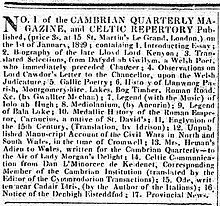This article is about the particular significance of the year 1922 to Wales and its people.
This article is about the particular significance of the year 1914 to Wales and its people.
This article is about the particular significance of the year 1911 to Wales and its people.
This article is about the particular significance of the year 1890 to Wales and its people.
This article is about the particular significance of the year 1882 to Wales and its people.
This article is about the particular significance of the year 1887 to Wales and its people.
This article is about the particular significance of the year 1888 to Wales and its people.
This article is about the particular significance of the year 1834 to Wales and its people.
This article is about the particular significance of the year 1826 to Wales and its people.
This article is about the particular significance of the year 1829 to Wales and its people.
This article is about the particular significance of the year 1817 to Wales and its people.
This article is about the particular significance of the year 1811 to Wales and its people.
This article is about the particular significance of the year 1810 to Wales and its people.
This article is about the particular significance of the year 1780 to Wales and its people.
This article is about the particular significance of the year 1778 to Wales and its people.

The Red Dragon, The National Magazine of Wales, was a monthly English-language literary magazine published in Cardiff, Wales, from February 1882 until June 1887. It was edited by Charles Wilkins until July 1885 when James Harris took over.

Critical and Miscellaneous Essays is the title of a collection of reprinted reviews and other magazine pieces by the Scottish essayist, historian and philosopher Thomas Carlyle. Along with Sartor Resartus and The French Revolution it was one of the books that made his name. Its subject matter ranges from literary criticism to biography, history and social commentary. These essays have been described as "Intriguing in their own right as specimens of graphic and original nonfiction prose…indispensable for understanding the development of Carlyle's mind and literary career", and the scholar Angus Ross has noted that the review-form displays in the highest degree Carlyle's "discursiveness, allusiveness, argumentativeness, and his sense of playing the prophet's part."
Arthur James Johnes was a Welsh county court judge.
This article is about the particular significance of the year 1713 to Wales and its people.



